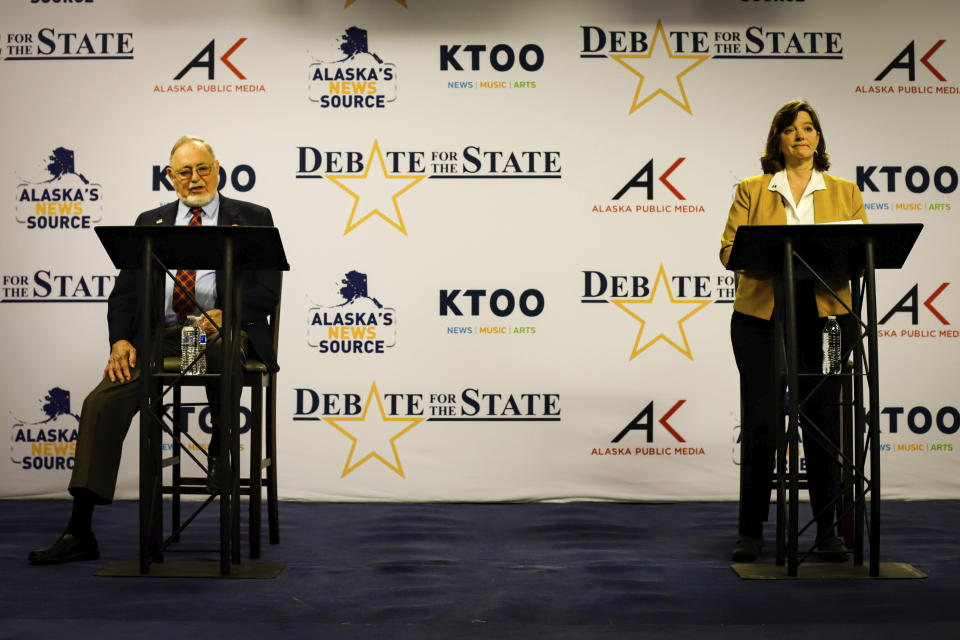8 Down-Ballot Races To Watch If Democrats Win Really Big

Republicans are already anticipating some losses in next week’s elections, but there’s a lingering nightmare scenario they also have to brace for: What happens if Democrats win big — like, really big?
Democrats’ top priority is kicking President Donald Trump out of office, but to actually enact their agenda they have to win back the Senate, expand their majority in the House and put more Democratic governors in office.
Democrats are reluctant to be too excited publicly about polls showing Joe Biden leading Trump, remembering the heartbreak of 2016 and knowing that the pandemic significantly complicates forecasting this election. But they have their eyes on seats their party hasn’t won in more than 50 years, and in states that Trump won by more than 20 percentage points.
These races are urban, suburban and rural — they stretch from Alaska, to the California foothills, to suburban Texas. To win would mean bringing high turnout among African American and Latinx voters, getting record numbers of young people to actually go to the ballot box and persuading conservative-leaning voters to switch parties.
The results of the election would have to look more like 2008, when Democrats were able to bring record enthusiasm in liberal strongholds, as well as hold on to traditionally more conservative centers in Ohio and Indiana, than 2018, where Democrats ceded key Senate races to Republicans despite gaining significant ground in House races.
It’s a tall order. Generic ballot polls show Democrats currently have a roughly seven-point advantage over Republicans this election cycle. HuffPost has identified eight races to watch if 2020 turns out to not only be a successful year for Democrats, but a blowout. This is by no means an exhaustive list.
Kansas Senate: Barbara Bollier (D) vs. Roger Marshall (R)
Bollier, a state senator, wants to be the first Democrat to win a Kansas Senate seat since the 1930s.

When Sen. Pat Roberts announced his retirement, Republicans weren’t concerned about holding his seat. Democrats, who haven’t won a Kansas Senate seat since the 1930s, figured they might have a shot if Kris Kobach ― known for his hardline anti-immigration views ― ran again, since the party managed to defeat him for the governor’s seat in 2018. Kobach did end up running for the Senate seat, but he lost the primary to Rep. Roger Marshall, a party-line Republican with a relatively low profile.
But Democratic nominee state Sen. Barbara Bollier, a former doctor who was a Republican legislator in the state as recently as 2018, is proving to be a competitive challenger. Bollier changed parties two years ago, citing “moral” objections to the GOP, and because she wanted to help expand Medicaid and fund education. She denounced the anti-transgender language added to the Kansas GOP’s platform and was a vocal critic of the Republican Party leadership ― particularly former Gov. Sam Brownback’s aggressive tax-cutting agenda.
She’s running on a public option for health care, funding public schools, protecting women’s health privacy and the pro-LGBTQ Equality Act. Her platform is carefully worded to avoid explicit mentions of abortion or gun access. Marshall, a staunchly pro-life OB-GYN, meanwhile, has been trying to appeal to Trump’s base, advocating to repeal and replace Obamacare and building a Southern border wall.
Bollier has raised five times more money than Marshall in October, and the polls show the two candidates either tied or with Marshall only a few points ahead. Kansas went for Trump by 21 points in 2016, but now Biden is less than 10 percentage points behind him in the polls.
Texas’ 2nd Congressional District: Rep. Dan Crenshaw (R) vs. Sima Ladjevardian (D)
The race gives Democrats a chance to take down a GOP rising star.

Democrats have long thought Texas would one day be in reach. If 2020 is the year Texas goes blue, or at least blue-ish, the wave will likely run through suburban districts like GOP Rep. Dan Crenshaw’s.
Democrat Sima Ladjevardian, a lawyer and former Beto O’Rourke adviser, says Texas’ second district, surrounding Houston, has completely changed since Crenshaw, the former United States Navy SEAL, was first elected to Congress two years ago. In 2016, Trump won 52% of the vote in this district. Then O’Rourke lost the area by just a percentage point in his 2018 Senate race.
Taking down Crenshaw will be a challenge; the freshman Republican’s profile has risen in his party, he’s a talented fundraiser and already has presidential buzz around him. But Ladjevardian, who immigrated to the United States as a kid from Iran, says the COVID-19 pandemic has changed people’s priorities. And the district’s increasingly young and diverse populations could make a difference.
North Carolina’s 11th Congressional District: Madison Cawthorn (R) vs. Moe Davis (D)
Mark Meadows’ old seat isn’t as conservative anymore.
Republican Madison Cawthorn wasn’t the GOP’s pick to replace White House Chief of Staff Mark Meadows in Congress. The 24-year-old beat out the Republican Party’s — and Trump’s — pick for the seat in a surprising upset and has since he’s been named a rising star in the party. He is facing Democrat Moe Davis, a former military prosecutor, who is running on a public option and expanding broadband internet — dire issues in western North Carolina.
Cawthorn, a parapalegic who became paralyzed from the waist down in a car accident in 2014, has been a controversial candidate. He was accused of sexual misconduct, which he responded to by saying the encounter was in good humor and calling the accusation politically motivated. In old now-deleted posts on Instagram, Cawthorn referred to Adolf Hitler with the honorific “Fuhrer” and called his visit to Hitler’s vacation home as a trip on his “bucket list.” More recently, his campaign created an attack website that went after a local reporter for working for “non-white males, like Cory Booker, who aims to ruin white males running for office.” Cawthorn said the line was a “syntax error,” meant to deride identity politics.
Tucked in the Appalachian mountains in the westernmost part of North Carolina, the 11th district has been dependable conservative stronghold; after all, Meadows, who shot up through the Tea Party movement and came to chair the ultra-conservative Trump-aligned Freedom Caucus, represented it.
But last year, North Carolina underwent a court-ordered redistricting that pushed Buncombe County, home to the liberal city of Asheville, within the 11th district’s boundaries — an attempt to course-correct for Republican gerrymandering.
Cawthorn is still favored, but Davis has released internal polling showing him beating the young Republican. If that’s true, it will likely signal a statewide swing in North Carolina, where Biden is proving to be competitive and there’s a high-profile Senate race.
California’s 4th Congressional District: Rep. Tom McClintock (R) vs. Brynne Kennedy (D)
Will the wildfires be a climate science denier’s undoing?
Rep. Tom McClintock, the most conservative member in California’s congressional delegation who is serving his 12th year in Congress, has long been on Democrats’ radar for unseating. His district spans most of northern California’s Sierra Nevada mountain range, including Lake Tahoe and down to Yosemite National Park.
McClintock is probably best known for being one of environmental groups’ biggest targets. As wildfires ravage the district year after year, McClintock still questions whether humans are an accelerating force in climate change. Instead, he uses the Trump line on the forest fires, pushing for more aggressive forest management.
Democrat Brynne Kennedy, who launched a software business and has become an author, is running on the national debt, health care and the climate crisis. The district has long been a conservative stronghold; Republicans still have a voter registration advantage over Democrats. But in some counties, that’s shifting, and there are a fair number of independent voters as well. It’s a race Democrats see as a possibility — especially in a big election year.
Kentucky’s Sixth Congressional District: Rep. Andy Barr (R) vs. Josh Hicks (D)
Another Democrat takes up Amy McGrath’s mission.

Josh Hicks is taking over Amy McGrath’s mission to kick Republican Rep. Andy Barr out of Congress. In 2018, McGrath proved that the district, which encompasses Lexington and the surrounding suburbs, wasn’t as solidly conservative as Republicans thought, with the former Marine fighter pilot coming within three points of the four-term congressman.
McGrath is now running a high-profile — albeit extremely long shot — bid against Senate Majority Leader Mitch McConnell (R), and Hicks ― a Marine veteran, former police officer and lawyer ― may benefit from an extremely energized Democratic base in Kentucky.
High voter turnout in Lexington played a big role in Democratic Gov. Andy Beshear’s victory in the 2019 race against the extremely unpopular Matt Bevin, and McGrath seems to be polling well in the district. Of course, a presidential election cycle is going to come with a different turnout altogether, but Hicks’ race is worth watching.
Alaska’s At-Large Congressional Seat: Rep. Don Young (R) vs. Alyse Galvin (D)
The race will test Alaska’s independent streak.
Love HuffPost? Become a founding member of HuffPost Plus today.

Alaska has an entirely Republican delegation in Congress. But the state has a strong independent streak that Democrats are hoping will come out in their favor if there is a major wave election.
There’s been a lot of attention on the state’s Senate race, which is between Sen. Dan Sullivan (R) and Al Gross, an independent candidate aligned with Democrats. If energy around that race holds, it might trickle down to the state’s only House member, Rep. Don Young, the 87-year-old Republican who is seeking his 25th term representing Alaska’s at-large district.
Alyse Galvin, who is also an independent, and an education activist, is running against Young a second time. In 2018, she fell just shy of 7 percentage points behind Young, and this time, she’s raising more money than him. Young, known in Washington for his bad behavior and abrasive style (he literally pulled a knife on John Boehner once), has spent his 48 years in Congress bringing federal funding back for Alaska. But Galvin says Young’s time has passed.
North Carolina’s 9th Congressional District: Rep. Dan Bishop (R) vs. Cynthia Wallace (D)
Republicans made it through a voter fraud scandal. Now they’re up against a blue wave.

North Carolina is a swing state — and much of that swing will be decided in suburban-rural areas like the 9th congressional district.
Last year, Republican Rep. Dan Bishop spent $6 million to win a narrow 51 percent to 49 percent win over Democrat Dan McCready in a district that Trump won by 12 percentage points. Bishop, known most for being the author of the famed anti-transgender “bathroom bill” in North Carolina, lost the Charlotte suburbs that Trump had won.
McCready isn’t running again. Democrat Cynthia Wallace, a black woman with a 25-year history in the financial services industry, is. Wallace, like most Democrats running in moderate suburban districts, has been focusing on health care, saying she will focus on lowering prescription costs and expanding COVID-19 testing if elected.
The 2019 race was an unusual one — the product of an absentee voting fraud scandal in 2018, when a GOP operative tampered with ballots, resulting in a special election. Since getting over that hurdle, Republicans in the state have been resting a little bit easier. But, while the race has gone a little under the radar, it’s still competitive. And in a year where there’s a competitive Senate and presidential race on the ballot, districts like the 9th could swing in a major wave.
Montana’s At-Large Congressional Seat: Matt Rosendale (R) vs. Kathleen Williams (D)
Democrats are in right races in Montana up and down the ballot.

Democrats had an early victory in Montana when the party convinced the state’s popular term-limited governor Steve Bullock to run for Senate. If Democrats prevail in Montana, the state’s open at-large House seat is also worth watching closely.
Rep. Greg Gianforte (R) ― famous for losing his temper and “body-slamming” a journalist ― is running for governor. Democrat Kathleen Williams, a former state legislator, is running for his vacant congressional seat a second time against Republican State Auditor Matt Rosendale. Polls are showing a close race, as Rosendale ties himself to Trump and Williams tries to cast herself as an independent. A New York Times Siena College poll showed Williams trailing Rosendale 50% to 46%.
Democrats are already hoping Montanans will split ballots in November for Bullock. Williams could get the benefit as well if there’s truly a big Democratic groundswell.
This article originally appeared on HuffPost and has been updated.

 Yahoo Finance
Yahoo Finance 
